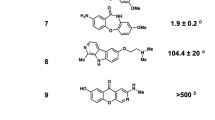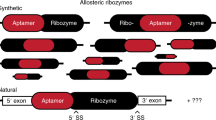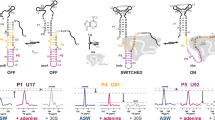Abstract
The glmS riboswitch belongs to the family of regulatory RNAs that provide feedback regulation of metabolic genes. It is also a ribozyme that self-cleaves upon binding glucosamine-6-phosphate, the product of the enzyme encoded by glmS. The ligand concentration dependence of intracellular self-cleavage kinetics was measured for the first time in a yeast model system and unexpectedly revealed that this riboswitch is subject to inhibition as well as activation by hexose metabolites. Reporter gene experiments in Bacillus subtilis confirmed that this riboswitch integrates positive and negative chemical signals in its natural biological context. Contrary to the conventional view that a riboswitch responds to just a single cognate metabolite, our new model proposes that a single riboswitch integrates information from an array of chemical signals to modulate gene expression based on the overall metabolic state of the cell.
This is a preview of subscription content, access via your institution
Access options
Subscribe to this journal
Receive 12 print issues and online access
$259.00 per year
only $21.58 per issue
Buy this article
- Purchase on SpringerLink
- Instant access to full article PDF
Prices may be subject to local taxes which are calculated during checkout





Similar content being viewed by others
References
Montange, R.K. & Batey, R.T. Riboswitches: emerging themes in RNA structure and function. Annu. Rev. Biophys. 37, 117–133 (2008).
Henkin, T.M. Riboswitch RNAs: using RNA to sense cellular metabolism. Genes Dev. 22, 3383–3390 (2008).
Roth, A. & Breaker, R.R. The structural and functional diversity of metabolite-binding riboswitches. Annu. Rev. Biochem. 78, 305–334 (2009).
Dambach, M.D. & Winkler, W.C. Expanding roles for metabolite-sensing regulatory RNAs. Curr. Opin. Microbiol. 12, 161–169 (2009).
Winkler, W.C., Nahvi, A., Roth, A., Collins, J.A. & Breaker, R.R. Control of gene expression by a natural metabolite-responsive ribozyme. Nature 428, 281–286 (2004).
Collins, J.A., Irnov, I., Baker, S. & Winkler, W.C. Mechanism of mRNA destabilization by the glmS ribozyme. Genes Dev. 21, 3356–3368 (2007).
McCarthy, T.J. et al. Ligand requirements for glmS ribozyme self-cleavage. Chem. Biol. 12, 1221–1226 (2005).
Donahue, C.P. & Fedor, M.J. Kinetics of hairpin ribozyme cleavage in yeast. RNA 3, 961–973 (1997).
Watson, P.Y. & Fedor, M.J. Determination of intracellular RNA folding rates using self-cleaving RNAs. Methods. Enzymol. 468, 259–286 (2009).
Klein, D.J., Been, M.D. & Ferré-D′Amaré, A.R. Essential role of an active-site guanine in glmS ribozyme catalysis. J. Am. Chem. Soc. 129, 14858–14859 (2007).
Cochrane, J.C., Lipchock, S.V., Smith, K.D. & Strobel, S.A. Structural and chemical basis for glucosamine 6-phosphate binding and activation of the glmS ribozyme. Biochemistry 48, 3239–3246 (2009).
Klein, D.J., Wilkinson, S.R., Been, M.D. & Ferré-D′Amaré, A.R. Requirement of helix P2.2 and nucleotide G1 for positioning the cleavage site and cofactor of the glmS ribozyme. J. Mol. Biol. 373, 178–189 (2007).
Burger, M. & Hejmová, L. Uptake of metabolizable sugars by Saccharomyces cerevisiae. Folia Microbiol. 6, 80–85 (1961).
Klein, D.J. & Ferré-D'Amaré, A.R. Structural basis of glmS ribozyme activation by glucosamine-6-phosphate. Science 313, 1752–1756 (2006).
Cochrane, J.C., Lipchock, S.V. & Strobel, S.A. Structural investigation of the glmS ribozyme bound to its catalytic cofactor. Chem. Biol. 14, 97–105 (2007).
Rizzi, M. et al. In vivo investigations of glucose transport in Saccharomyces cerevisiae. Biotechnol. Bioeng. 49, 316–327 (1996).
Sellick, C.A., Campbell, R.N. & Reece, R.J. Galactose metabolism in yeast—Structure and regulation of the Leloir pathway enzymes and the genes encoding them. Int. Rev. Cell Mol. Biol. 269, 111–150 (2008).
Nevoigt, E. & Stahl, U. Osmoregulation and glycerol metabolism in the yeast Saccharomyces cerevisiae. FEMS Microbiol. Rev. 21, 231–241 (1997).
Albe, K.R., Butler, M.H. & Wright, B.E. Cellular concentrations of enzymes and their substrates. J. Theor. Biol. 143, 163–195 (1990).
Freese, E.B., Cole, R.M., Klofat, W. & Freese, E. Growth, sporulation, and enzyme defects of glucosamine mutants of Bacillus subtilis. J. Bacteriol. 101, 1046–1062 (1970).
Bates, C.J. & Pasternak, C.A. Further studies on the regulation of amino sugar metabolism in Bacillus subtilis. Biochem. J. 96, 147–154 (1965).
Blencke, H.M. et al. Transcriptional profiling of gene expression in response to glucose in Bacillus subtilis: regulation of the central metabolic pathways. Metab. Eng. 5, 133–149 (2003).
Sudarsan, N. et al. Tandem riboswitch architectures exhibit complex gene control functions. Science 314, 300–304 (2006).
Montange, R.K. et al. Discrimination between closely related cellular metabolites by the SAM-I riboswitch. J. Mol. Biol. 396, 761–772 (2010).
Montange, R.K. & Batey, R.T. Structure of the S-adenosylmethionine riboswitch regulatory mRNA element. Nature 441, 1172–1175 (2006).
Tomsic, J., McDaniel, B.A., Grundy, F.J. & Henkin, T.M. Natural variability in S-adenosylmethionine (SAM)-dependent riboswitches: S-box elements in Bacillus subtilis exhibit differential sensitivity to SAM In vivo and in vitro. J. Bacteriol. 190, 823–833 (2008).
Wilkinson, S.R. & Been, M.D. A pseudoknot in the 3′ non-core region of the glmS ribozyme enhances self-cleavage activity. RNA 11, 1788–1794 (2005).
Norrander, J., Kempe, T. & Messing, J. Construction of improved M13 vectors using oligodeoxynucleotide-directed mutagenesis. Gene 26, 101–106 (1983).
Donahue, C.P., Yadava, R.S., Nesbitt, S.M. & Fedor, M.J. The kinetic mechanism of the hairpin ribozyme in vivo: influence of RNA helix stability on intracellular cleavage kinetics. J. Mol. Biol. 295, 693–707 (2000).
Sikorski, R.S. & Hieter, P. A system of shuttle vectors and yeast host strains designed for efficient manipulation of DNA in Saccharomyces cerevisiae. Genetics 122, 19–27 (1989).
Dunn, A.K. & Handelsman, J. A vector for promoter trapping in Bacillus cereus. Gene 226, 297–305 (1999).
Geiser, M., Cebe, R., Drewello, D. & Schmitz, R. Integration of PCR fragments at any specific site within cloning vectors without the use of restriction enzymes and DNA ligase. Biotechniques 31, 88–90, 92 (2001).
He, F., Amrani, N., Johansson, M.J.O. & Jacobson, A. Qualitative and quantitative assessment of the activity of the yeast nonsense-mediated mRNA decay pathway. in RNA Turnover in Eukaryotes: Analysis of Specialized and Quality Control RNA Decay Pathways Vol. 449, 127–147 (Elsevier Academic Press, San Diego, 2008).
Milligan, J.F. & Uhlenbeck, O.C. Synthesis of small RNAs using T7 RNA polymerase. Methods Enzymol. 180, 51–62 (1989).
Long, D.M. & Uhlenbeck, O.C. Kinetic characterization of intramolecular and intermolecular hammerhead RNAs with stem II deletions. Proc. Natl. Acad. Sci. USA 91, 6977–6981 (1994).
Cheng, Y. & Prusoff, W.H. Relationship between the inhibition constant (K1) and the concentration of inhibitor which causes 50 per cent inhibition (I50) of an enzymatic reaction. Biochem. Pharmacol. 22, 3099–3108 (1973).
Anagnostopoulos, C. & Spizizen, J. Requirements for transformation in Bacillus subtilis. J. Bacteriol. 81, 741–746 (1961).
Acknowledgements
This work was supported by US National Institutes of Health grant RO1 GM062277 (M.J.F.). P.Y.W. was supported by a graduate fellowship from The Skaggs Institute for Chemical Biology. We thank J. Pogliano for advice regarding the Bacillus subtilis experiments, J. Viladoms and M. Saha for assistance with plasmid constructions, and J.V. for critical reading of the manuscript.
Author information
Authors and Affiliations
Contributions
P.Y.W. and M.J.F. conceived of and designed the experiments, analyzed the data and wrote the paper. P.Y.W. conducted the experiments.
Corresponding author
Ethics declarations
Competing interests
The authors declare no competing financial interests.
Supplementary information
Supplementary Text and Figures
Supplementary Figure 1 and Supplementary Table 1 (PDF 134 kb)
Rights and permissions
About this article
Cite this article
Watson, P., Fedor, M. The glmS riboswitch integrates signals from activating and inhibitory metabolites in vivo. Nat Struct Mol Biol 18, 359–363 (2011). https://doi.org/10.1038/nsmb.1989
Received:
Accepted:
Published:
Issue date:
DOI: https://doi.org/10.1038/nsmb.1989
This article is cited by
-
On the mechanisms of lysis triggered by perturbations of bacterial cell wall biosynthesis
Nature Communications (2023)
-
A cell-based ribozyme reporter system employing a chromosomally-integrated 5′ exonuclease gene
BMC Molecular and Cell Biology (2021)
-
The case of the missing allosteric ribozymes
Nature Chemical Biology (2021)
-
Engineering a vitamin B12 high-throughput screening system by riboswitch sensor in Sinorhizobium meliloti
BMC Biotechnology (2018)
-
Recent advances and future trends of riboswitches: attractive regulatory tools
World Journal of Microbiology and Biotechnology (2018)



